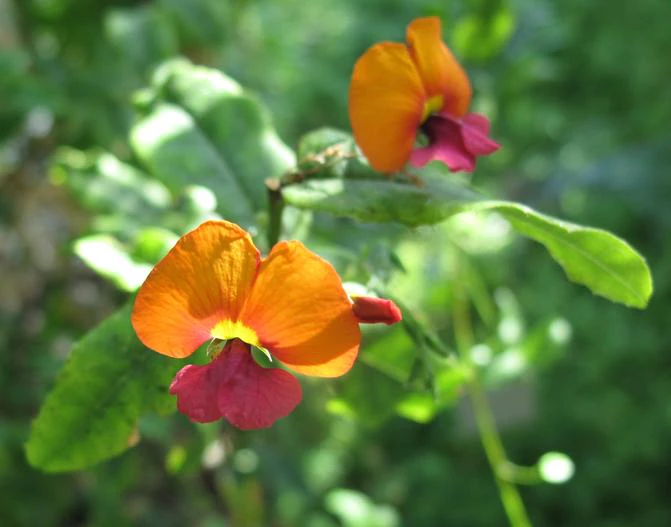Heart-Leaf Flame Pea
(Chorizema cordatum)
Heart-Leaf Flame Pea (Chorizema cordatum)
/
/

HelenaH
CC BY-SA 3.0
Image By:
HelenaH
Recorded By:
Copyright:
CC BY-SA 3.0
Copyright Notice:
Photo by: HelenaH | License Type: CC BY-SA 3.0 | License URL: https://creativecommons.org/licenses/by-sa/3.0 | Uploader: HelenaH | Publisher: Wikipedia Commons



















Estimated Native Range
Climate Requirements for Perth, Australia
| This Plant | Your Site | Plant Suitability for Your Location | ||
|---|---|---|---|---|
| • Precipitation | 14" - 52" | 30" | Your precipitation may be insufficient for this plant. Irrigate N" / year. | Irrigate N" / year |
| • High Temp. | 72°F - 95°F | 88°F | Your summer temperatures are normal for this plant. | Excellent |
| • Low Temp. | 19°F - 50°F | 49°F | Your winter temperatures are normal for this plant | Excellent |
This plant should grow well at your location with about N inches per year (Y minutes per month) of irrigation.
Summary
Chorizema cordatum, commonly known as Heart-Leaf Flame Pea, is an evergreen shrub native to the open woodlands and forest margins of Southwestern Australia. It typically grows to a height of 1-2 meters with a similar spread, featuring a bushy habit with heart-shaped leaves. The striking flowers are a major attraction, showcasing vibrant orange and red hues in long racemes, and they bloom profusely from late winter to spring, offering a spectacular display. The flowers, approximately 10 to 12 mm in diameter, are particularly showy, making this plant a favorite among gardeners for adding a splash of color to the landscape.
Heart-Leaf Flame Pea is valued for its ornamental flowers and its ability to thrive in areas with lower humidity, making it suitable for Mediterranean climates. It is often used in residential gardens for border planting or as a feature shrub. While it does not tolerate frost, it can be grown in cooler regions under glass protection. This shrub requires well-drained soil, preferably sandy or loamy, and benefits from regular watering, though it can withstand short dry periods. It has earned the Royal Horticultural Society’s Award of Garden Merit, indicating its exceptional performance in gardens. Potential problems include susceptibility to root rot in poorly drained soils and damage from frost in cooler climates. Propagation is straightforward from seed or cuttings, which strike readily, allowing gardeners to easily multiply their stock.CC BY-SA 4.0
Heart-Leaf Flame Pea is valued for its ornamental flowers and its ability to thrive in areas with lower humidity, making it suitable for Mediterranean climates. It is often used in residential gardens for border planting or as a feature shrub. While it does not tolerate frost, it can be grown in cooler regions under glass protection. This shrub requires well-drained soil, preferably sandy or loamy, and benefits from regular watering, though it can withstand short dry periods. It has earned the Royal Horticultural Society’s Award of Garden Merit, indicating its exceptional performance in gardens. Potential problems include susceptibility to root rot in poorly drained soils and damage from frost in cooler climates. Propagation is straightforward from seed or cuttings, which strike readily, allowing gardeners to easily multiply their stock.CC BY-SA 4.0
Plant Description
- Plant Type: Shrub
- Height: 0.5-3 feet
- Width: 2-3 feet
- Growth Rate: Moderate
- Flower Color: Orange, Pink
- Flowering Season: Fall, Winter, Spring, Summer
- Leaf Retention: Evergreen
Growth Requirements
- Sun: Full Sun, Part Shade
- Water: Medium
- Drainage: Medium, Fast
Common Uses
Border Plant, Low Maintenance, Showy Flowers
Natural Habitat
Open woodlands and forest margins of Southwestern Australia
Other Names
Common Names: Australian Flame Pea, Kängurubuske
Scientific Names: Chorizema cordatum, Chorizema cordatum var. elegans, Chorizema cordatum var. spinosissimum, Chorizema cordatum var. splendens, Chorizema flavum, Chorizema superbum
GBIF Accepted Name: Chorizema cordatum Lindl.